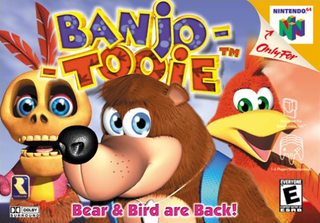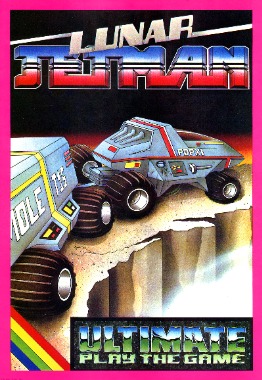Ashby Computers and Graphics Limited, trading as Ultimate Play the Game, was a British video game developer and publisher, founded in 1982, by ex-arcade video game developers Tim and Chris Stamper. Ultimate released a series of successful games for the ZX Spectrum, Amstrad CPC, BBC Micro, MSX and Commodore 64 computers from 1983 until 1987. Ultimate are perhaps best remembered for the big-selling titles Jetpac and Sabre Wulf, each of which sold over 300,000 copies in 1983 and 1984 respectively, and their groundbreaking series of isometric arcade adventures using a technique termed Filmation. Knight Lore, the first of the Filmation games, has been retrospectively described in the press as "seminal ... revolutionary" (GamesTM), "one of the most successful and influential games of all time" (X360), and "probably ... the greatest single advance in the history of computer games" (Edge).

GoldenEye 007 is a 1997 first-person shooter video game developed by Rare and published by Nintendo for the Nintendo 64. It is based on the 1995 James Bond film GoldenEye, with the player controlling the secret agent James Bond to prevent a criminal syndicate from using a satellite weapon. They navigate a series of levels to complete objectives, such as recovering or destroying objects, while shooting enemies. In a multiplayer mode, up to four players compete in several deathmatch scenarios via split-screen.

Banjo-Tooie is a 2000 platform game developed by Rare and published by Nintendo for the Nintendo 64 console. It is the second game in the Banjo-Kazooie series and the sequel to Banjo-Kazooie. The game follows the returning protagonists Banjo and Kazooie as they attempt to stop the plans of the witch Gruntilda and two of her sisters, who intend to vaporise the inhabitants of the game's island setting. The game features worlds significantly larger than those of its predecessor, requiring the player to complete challenges such as solving puzzles, jumping over obstacles, collecting items, and defeating opponents. It also includes a multiplayer mode in which up to four players can compete in several minigames repurposed from the main campaign.

Jetpac is a shooter video game developed and published by Ultimate Play the Game and released for the ZX Spectrum and VIC-20 in 1983 and the BBC Micro in 1984. It is the first game to be released by Ultimate Play the Game, the company which later became Rare. The game follows Jetman as he must rebuild his rocket in order to explore different planets, while simultaneously defending against hostile aliens. It was written by Ultimate co-founder Chris Stamper with graphics designed by his brother, Tim Stamper. Reviewers praised Jetpac's presentation and gameplay, and it won "Game of the Year" at the Golden Joystick Awards in 1983.

Solar Jetman: Hunt for the Golden Warpship is a multidirectional shooter video game developed by Zippo Games and Rare and published by Tradewest for the Nintendo Entertainment System. It was released in North America on 14 October 1990 and in Europe by Nintendo on 26 September 1991. The game is the third installment of the Jetman series and was later re-released by Nintendo for their NES-based PlayChoice-10 arcade system in the United States in 1990.

Paperboy is an arcade action game developed and published by Atari Games, and released in 1985. The player takes the role of a paperboy who delivers a fictional newspaper called The Daily Sun along a street on his bicycle. The arcade version of the game featured bike handlebars as the controller.

Super Puzzle Fighter II Turbo, released in Japan as Super Puzzle Fighter II X, is a tile-matching puzzle video game released in 1996 for the CP System II (CPS2) arcade board, by Capcom and its Capcom Coin-Op division. The game's title is a play on Super Street Fighter II Turbo, as there were no other Puzzle Fighter games at the time, and the game includes music and interface elements spoofing the Street Fighter Alpha and Darkstalkers games. It was a response to Sega's Puyo Puyo 2 that had been sweeping the Japanese arcade scene.

Pac-Attack, also known as Pac-Panic, is a 1993 falling-tile puzzle video game developed and published by Namco for the Super Nintendo Entertainment System and Sega Genesis. Versions for the Game Boy, Game Gear and Philips CD-i were also released. The player is tasked with clearing out blocks and ghosts without them stacking to the top of the playfield — blocks can be cleared by matching them in horizontal rows, while ghosts can be cleared by placing down a Pac-Man piece that can eat them. It is the first game in the Pac-Man series to be released exclusively for home platforms.

Burnout Revenge is a 2005 racing video game developed by Criterion Games and published by Electronic Arts for PlayStation 2, Xbox and Xbox 360.

Lunar Jetman is a horizontally scrolling shooter developed and published by Ultimate Play the Game. It was released for the ZX Spectrum in 1983 and later on the BBC Micro. In this sequel to Jetpac, the second instalment of the Jetman series, Jetman has to destroy alien bases whilst simultaneously defending himself, along with Earth, from a hostile alien race.

Marvel vs. Capcom 2: New Age of Heroes is a crossover fighting game developed and published by Capcom. It is the fourth installment in the Marvel vs. Capcom series, which features characters from both Capcom's video game franchises and comic book series published by Marvel Comics. Originally released in Japanese arcades in 2000, the game received ports to the Dreamcast, PlayStation 2, PlayStation 3, Xbox, Xbox 360, and iOS devices over the span of twelve years.

Rockstar Games Presents Table Tennis is a 2006 table tennis simulation video game developed by Rockstar San Diego and published by Rockstar Games. The game is a realistic simulation of the sport table tennis, with the main objective to make the opponent fail to hit the ball.

Band of Bugs is a turn-based tactics video game developed by NinjaBee. The game includes a level editor, leaderboards, Xbox Live Vision camera support, and multiplayer gameplay. It was released for the Xbox 360 via Xbox Live Arcade on June 20, 2007.
Shrek n' Roll is a video game developed by Backbone Entertainment and published by Activision on November 14, 2007. The puzzle game was released on the Xbox 360.

Digger T. Rock: Legend of the Lost City is a platform game developed by Rare and published by the Milton Bradley Company for the Nintendo Entertainment System. It was first released in North America in December 1990 and in Europe in 1991. The game centres around the miner Digger T. Rock, as he spelunks various caves and catacombs whilst searching for the mythical Lost City.

Galaga Legions is a 2008 twin-stick shooter video game developed and released by Namco Bandai Games for the Xbox 360. It is the twelfth game in the Galaxian series, and the third developed for home platforms. The player controls a starship, the AEf-7 "Blowneedle", in its efforts to wipe out the Galaga armada. The objective of the game is to clear each of the five stages as quick as possible. Stages have a heavy emphasis on puzzle solving and chain reactions, which are necessary to clear out enemy formations. The Blowneedle has a pair of satellites at its disposal, and can place them anywhere on the screen to fend off enemies.

Snoopy Flying Ace is a dogfighting video game based on Charles M. Schulz's Peanuts franchise and developed by Smart Bomb Interactive for the Xbox Live Arcade service on the Xbox 360. It was announced on November 10, 2008 and released on June 2, 2010. An unofficial sequel to the 2006 video game Snoopy vs. the Red Baron, it features a similar World War I setting. Snoopy is tasked with defeating several members of the Flying Circus, a special flight squadron in the Luftstreitkräfte, and its commander, Manfred von Richthofen, also known as the Red Baron.

Marvel vs. Capcom Origins is a crossover fighting video game developed by Iron Galaxy Studios and published by Capcom. It is a compilation of Marvel Super Heroes (1995) and Marvel vs. Capcom: Clash of Super Heroes (1998). The dual pack was released through the PlayStation Network and Xbox Live Arcade in September and October 2012, respectively.

Rare Replay is a 2015 compilation of 30 video games from the 30-year history of developers Rare and its predecessor, Ultimate Play the Game. The emulated games span multiple genres and consoles—from the ZX Spectrum to the Xbox 360—and retain the features and errors of their original releases with minimal edits. The compilation adds cheats to make the older games easier and a Snapshots mode of specific challenges culled from parts of the games. Player progress is rewarded with behind-the-scenes footage and interviews about Rare's major and unreleased games.

Kameo: Elements of Power is a 2005 action-adventure video game developed by Rare and published by Microsoft Game Studios. The player controls Kameo, a 16-year-old elf, who must travel across the land, rescuing her family while collecting Elemental Sprites and Warriors in a beat 'em up style combat against the trolls that stand in her way. Kameo's ten elemental powers let her transform into creatures and use their varied abilities to solve combat-oriented puzzles and progress through the game's levels.



















